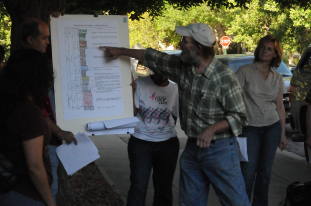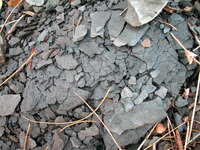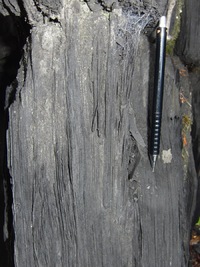In shale gas exploration, one of the most slippery attributes we are interested in is fracability. The problem is that the rocks we study have different compositions and burial histories, so it's hard to pin down the relative roles of intrinsic rock properties and extrinsic stress states. Glass could be considered an end member for brittleness, and it has fairly uniform elastic parameters and bulk composition (it's amorphous silica). Perhaps we can learn something about the role of stresses by looking more closely at how glass fractures.
The mechanics of glass can be characterized by two aspects: how it's made, and how it breaks.
Annealed glass is made by pouring molten glass onto a thin sheet of tin. Upon contact, the tin melts allowing for two perfectly smooth and parallel surfaces. The glass is cooled slowly so that stress irregularities dissipate evenly throughout, reducing local weak points. This is ordinary glass, as you might find in a mirror.
 Tempered glass is made by heating annealed glass to near its softening point, about 720˚C, and then quickly cooling it by quenching with air jets. The exterior surface shrinks, freezing it into compression, while the soft interior of the glass gets pulled out by tensional forces as it freezes (diagram).
Tempered glass is made by heating annealed glass to near its softening point, about 720˚C, and then quickly cooling it by quenching with air jets. The exterior surface shrinks, freezing it into compression, while the soft interior of the glass gets pulled out by tensional forces as it freezes (diagram).
How glass is made is directly linked to how it breaks. Annealed glass is weaker, and breaks into sparse splinters. The surface of tempered glass is stronger, and when it breaks, it breaks catastrophically; the interior tensional energy releases cracks from the inside out.
 A piece of tempered glass is 4-6 times stronger than a piece of annealed glass with the same elastic properties, composition, density and dimensions. This means it looks almost identical but requires much more stress to break. Visually and empirically, it is not easy to tell the difference between annealed and tempered glass. But when you break it, the difference is obvious. So here, for two very brittle materials, with all else being equal, the stress state plays the dominant role in determining the mode of failure.
A piece of tempered glass is 4-6 times stronger than a piece of annealed glass with the same elastic properties, composition, density and dimensions. This means it looks almost identical but requires much more stress to break. Visually and empirically, it is not easy to tell the difference between annealed and tempered glass. But when you break it, the difference is obvious. So here, for two very brittle materials, with all else being equal, the stress state plays the dominant role in determining the mode of failure.
Because natural permeability is so low in fine grained rocks, production companies induce artificial fractures to connect flow pathways to the wellbore. The more surface area exposed, the more methane will be liberated.
If we are trying to fracture-stimulate shale to get at the molecules trapped inside, we would clearly prefer shale that shatters like tempered glass. The big question is: how do we explore for shale like this?
One approach is to isolate parameters such as natural fractures, anisotropy, pore pressure, composition, and organic content and study their independent effects. In upcoming posts, we'll explore the tools and techniques for measuring these parameters across scale space for characterizing fracability.
Update on 2011-04-19 15:59 by Matt Hall
You might also like some of our other recent posts about shale gas:
 On my last day in Colorado, I went on a field trip to learn about the geology of the area. The main event was a trip to the Lyons Cemex quarry north of Boulder, where they mine the Niobrara formation to make cement. Interestingly, the same formation is being penetrated for oil and gas beneath the surface only a few thousand metres away. Apparently, the composition of the Niobrara is not desireable for construction or building materials, but it makes the ideal cement for drilling and completion operations. I find it almost poetic that the western-uplifted part of the formation is mined so that the eastern-deeper parts can be drilled; a geologic skin-graft, of sorts...
On my last day in Colorado, I went on a field trip to learn about the geology of the area. The main event was a trip to the Lyons Cemex quarry north of Boulder, where they mine the Niobrara formation to make cement. Interestingly, the same formation is being penetrated for oil and gas beneath the surface only a few thousand metres away. Apparently, the composition of the Niobrara is not desireable for construction or building materials, but it makes the ideal cement for drilling and completion operations. I find it almost poetic that the western-uplifted part of the formation is mined so that the eastern-deeper parts can be drilled; a geologic skin-graft, of sorts...














 Except where noted, this content is licensed
Except where noted, this content is licensed